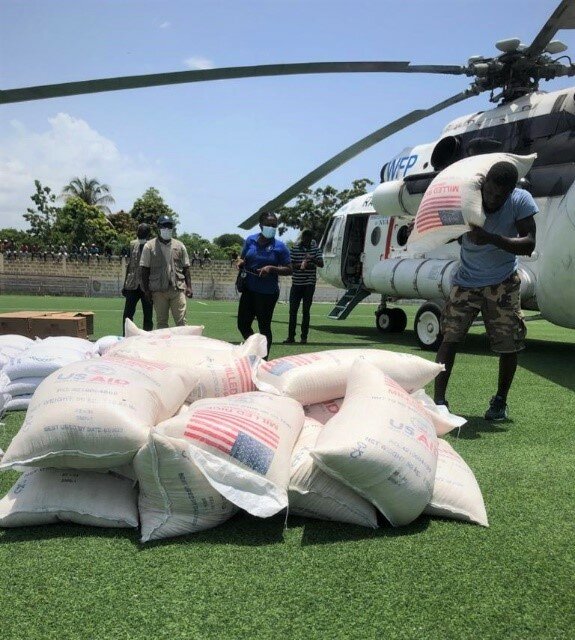WFP responds to tremors caused by the security crisis in Haiti

The World Food Programme wasted no time in responding when, on 14 August, a 7.2 magnitude earthquake hit Haiti’s southern peninsula, killing more than 2,200 people, leaving up to 12,000 injured.
Many were displaced as homes, land and the already vulnerable country’s infrastructure were destroyed.
Since January, WFP has been providing emergency assistance to more than 800,000 people in Haiti, over twice as much as last year. But now the organization finds that it is responding to an altogether different crisis: responding to the displacements caused by the security crisis.
Before the earthquake, weeks of clashes between armed groups in the poor neighborhood of Martissant, in the greater Port-au-Prince area, led to the displacement of up to 20,000 people. Many are yet to return to their homes.
For humanitarians to bypass the threat of violence and access people in need throughout the country, helicopter remains the most reliable way tool to deliver aid.
Indeed, for two months, an air bridge carrying personnel and critical assistance ran between the capital Port-au-Prince and Gressier, a small community located on the coast just a few kilometers from the city centre.

Its neighborhoods, including Bel Air, Martissant, and parts of Delmas, had by that point become notorious in the region.
They are where, in early June, violent confrontations between gangs forced people to flee their homes.
“We left as fast as we could,” said Valéry, a resident of Martissant. “Bullets were firing in all directions. With my wife who is expecting a baby, we didn't have the time to take anything. I know that they burned our house. We have nothing left.”
Following the clashes in June, the town hall of a neighbouring community, Carrefour, provided temporary shelter to the more than 1,500 people displaced after the gang violence in Martissant.
People in a vast sports centre, including those who've lost everything, still strive to survive in difficult conditions and try to find hope and rebuild their lives. In total, 1.5 million people were affected by the recent violence and nearly 20,000 were displaced, sometimes separated from their families, or taken in by locals.

The national highway, which links four of the country’s ten departments, still remains largely controlled by gangs just outside of Port-au-Prince. The south of the country is largely inaccessible; although humanitarian convoys manage to use this route when the security situation allows.
And, in order to provide emergency assistance to the displaced people of Martissant, and other neighborhoods close to the capital, air travel has remained the safest option.
Since June, the WFP-managed Humanitarian Air Service (UNHAS) has flown to earthquake-affected areas, transporting several tons of vital assistance, as well as the humanitarian personnel supporting the coordination of activities with local authorities.
“We doubled our flights from May to June,” says Giuseppe Didiano, head of UNHAS in Haiti. “This air bridge allowed us to deliver aid from our humanitarian partners to assist the displaced.”
In the sports centre, a proper team effort took place between local authorities and civil protection – managing the day-to-day work onsite with humanitarian personnel. While the town hall distributed chocolate or biscuits in the morning, other partners provided hygiene kits, water, and other essential equipment. WFP provided two meals a day as well as fortified food to women and children.
For Chéry, who is five months pregnant, and her 3-year-old girl, moving on is a constant worry. Until recently she had a home,a grocery store she ran, while her husband had a job. “My daughter often asks me when she can go back to school. I tell her she will be going soon but I have no idea,” she says. Chéry struggles not to lose hope for the possibility of a calm and peaceful life for herself and her family. Every day, she says, she awaits the help that will allow her to feed her loved ones.
Contributions from Canada, the European Union, France, Germany, Japan, Switzerland, the United Nations Central Emergency Response Fund (CERF) and the U.S. Agency for International Development (USAID/BHA) enable UNHAS to maintain its flights in 2021.



